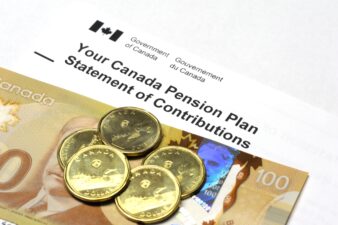Investors looking to create a recurring source of passive income at a low cost can gain exposure to asset classes such as bonds or equities. Fixed-income products such as Treasury Bills in the U.S. have gained popularity in the last two years due to interest rate hikes. In fact, Warren Buffett’s Berkshire Hathaway is among the largest purchasers of T-bills in the U.S. and has allocated close to US$160 billion towards this product.
Moreover, investing in quality blue-chip dividend stocks is another strategy for beginning a passive-income stream. Here, you need to identify companies that are market leaders with a competitive moat that allows them to generate steady cash flows and maintain their dividend payouts across business cycles.
Should you invest in GICs?
A popular fixed-income product in Canada is Guaranteed Investment Certificates, or GICs. The interest rate hikes since 2022 have allowed investors to lock in a yield of over 5%, which means an investment of $5,000 will help you earn $250 in annual interest payments.
A GIC is an investment that lets you earn interest on a principal amount for a certain time period, after which you will get your initial deposit amount back. In 2024, several banks offer investors a yield of 5%, making it an ideal investment for those with a low-risk appetite.
A GIC purchased through a bank is protected by the Canadian Deposit Insurance Corporation. So, even if your bank defaults to pay you interest, you will still receive your principal amount of up to $100,000. However, investors should note that the guarantee applies to GICs with terms of five years or less.
Given that inflation rates are cooling down, GICs should be part of your investment portfolio as they offer diversification and lower overall risk. Younger investors can consider allocating up to 25% of their savings to GICs, and this number can be higher for older investors.
Should you invest in dividend stocks?
There are plenty of dividend stocks trading on the TSX but just a handful of them are positioned to beat the broader markets over time. One such TSX dividend stock with a tasty dividend yield is Enbridge (TSX:ENB), a diversified energy infrastructure company.
Valued at $105 billion by market cap, Enbridge pays shareholders an annual dividend of $3.66 per share, translating to a yield of 7.4%.
While this yield might seem unsustainable, Enbridge generates enough cash to meet its dividend and other financial obligations. Moreover, a majority of Enbridge’s cash flows are tied to inflation-linked long-term contracts, shielding it from volatility in commodity prices.
This cash flow visibility has allowed Enbridge to raise its dividends by 10% annually on average over the last 29 years. The energy giant aims to maintain a payout ratio of less than 70%, which provides it with the flexibility to reinvest in organic growth, target accretive acquisitions, lower balance sheet debt, and further raise dividends.
Priced at 16.3 times forward earnings, ENB stock trades at a 10% discount to consensus price targets. If we account for dividends total returns may be closer to 17% in the next 12 months.
Creating a diversified portfolio is key to generating long-term wealth. Canadian investors should invest across asset classes, which may include GICs, equities, and exchange-traded funds, based on their risk appetite and other such factors.








